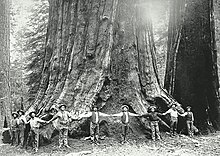The General Noble Tree was a monumental giant sequoia (Sequoiadendron giganteum) situated in the Converse Basin Grove, within the boundaries of the Giant Sequoia National Monument, in Fresno County, California. It was believed to be the biggest tree in the world before it was felled in 1892 to become an exhibition tree at the World's Columbian Exposition in Chicago.[1][2] It was the largest tree ever felled.[3]
| General Noble Tree | |
|---|---|
 The felling crew holds hands around the base of the General Noble. | |
| Species | Giant sequoia (Sequoiadendron giganteum) |
| Coordinates | 36°47′35″N 118°58′53″W / 36.79319°N 118.98135°W |
| Diameter | 9 m (30 ft) |
Description
editStanding at an impressive height of 300 feet (91 m) with a ground circumference of 95 feet (29 m), the General Noble Tree was a symbol of nature's grandeur. It was the second largest tree in the Converse Basin Grove, only surpassed by the Boole Tree, and was listed among the top 30 largest trees by volume worldwide prior to its felling.[3][4] The tree, named after Secretary of the Interior John Willock Noble, was situated just outside the borders of Sequoia National Park.[4]: 8 Despite Noble's recommendation for the establishment of the national park, which resulted in the protection of many sequoias, his namesake tree fell outside federal protection, which led to its cutting.
Transportation
editThe process of cutting and moving the General Noble Tree was arduous and costly. The tree had to be hollowed out and segmented, which were then transported by teams of 16 mules pulling specialized wagons over a rough mountain road. The King's River Lumber Company executed this demanding task, dividing the tree into 46 smaller sections, some of which weighed over 4 tons each. These sections were then transported by train, requiring 11 railroad cars to complete the journey from California to Chicago. The total cost of cutting, shipping, and installing the tree amounted to $10,475.87.[4]: 8
C.C. Curtis photographed the felling of the tree, an act that helped establish the public's belief in the existence of the giant sequoias.
-
A scaffolding system allowed workers to make the first cut fifty feet from the ground.
-
The General Noble Tree falls.
-
Workers begin dismantling the tree into sections.
-
Jesse Pattee, a renowned logger, is the first man on the left.
-
Five men in the freshly cut trunk.
-
Loading the General Noble into a mule driven wagon.
-
The painstaking journey down the mountain.
Display
editThe General Noble Tree was displayed at the 1893 World's Columbian Exposition in Chicago, where it was met with skepticism, earning the nickname "California Hoax" by those who doubted the authenticity of its massive size.[5] After the exposition, the tree was transported to Washington D.C., where it was transformed into a house-like structure and placed in front of the Main Building of the Department of Agriculture.[6] It served as a popular tourist attraction for over 40 years until it eventually decayed.[7]
Legacy: Chicago Stump
editToday, the Chicago Stump, the remnants of the former General Noble Tree, stands as a 20-foot-high symbol in the Converse Basin Grove, testifying to the extensive logging of the late 19th century.[8]
Reaching the stump is straightforward. From Grant Grove Village, drive three miles north on State Highway 180, known as the Kings Canyon Scenic Byway. Then, turn onto Forest Road 13S03 and continue for another 2.8 miles to arrive at the Chicago Stump trailhead. The Chicago Stump itself is easily accessible through a flat, half-mile long trail called the Chicago Stump Trail.[9]
During the 2015 Rough Fire in the Converse Basin area, firefighters ensured its survival by protecting the Chicago Stump with fire-resistant shelters.
Dimensions
edit| Height above base | 300 ft | 91.4 m |
|---|---|---|
| Circumference at ground | 95 ft | 29.0 m |
See also
editReferences
edit- ^ See McGraw, Donald J., "The Tree That Crossed A Continent", California History, Volume LXI, Number 2 (Summer 1982).
- ^ "A Mammoth Tree, It Will Represent California Forests at the World's Fair". Hanford Journal (Weekly). Vol. II, no. 17. 9 August 1892. Retrieved 7 July 2023.
- ^ a b See Flint, Wendell D., "To Find The Biggest Tree", Sequoia Natural History Association (1987).
- ^ a b c McDougall Weiner, Jackie (2009). Timely Exposures: The Life and Images of C.C. Curtis, Pioneer California Photographer. Tulare, California: Tulare County Historical Society.
- ^ "Sequoia National Forest - Chicago Stump Trailhead". Fs.usda.gov. Retrieved 2022-09-17.
- ^ "Transported California Tree". San Jose Mercury-news. Vol. XLIX, no. 56. 1896-02-25. Retrieved 2023-07-07.
- ^ McGraw, Donald J., "The Tree That Crossed A Continent", California History, Volume LXI, Number 2 (Summer 1982)
- ^ "Converse Basin Grove". U.S. Department of Agriculture Forest Service. Retrieved 7 July 2023.
- ^ National Park Service. "Sequoia & Kings Canyon". U.S. Department of the Interior. Retrieved 7 July 2023.
External links
edit
